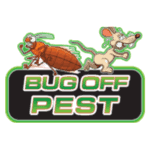Pest Library
Welcome to the Bug Off Pest Library, the complete resource for identifying and understanding pests that affect homes, farms, and businesses across Charlotte, Sarasota, Lee & DeSoto Counties.
Florida’s warm, humid climate creates the perfect environment for pests to thrive year-round. This guide will help you identify the most common invaders and learn how to protect your property through expert pest control solutions from Bug Off Pest.
Ants & Colonies
Ants are among the most common pests in Florida homes and lawns. Fire ants sting painfully and damage yards, while carpenter ants weaken wooden structures by burrowing through them. Ghost and pharaoh ants infest kitchens, bathrooms, and electrical areas. Sealing cracks, removing moisture, and using bait systems help control colonies effectively.
Termites & Wood Destroyers
Termites feed on wood and cause costly structural damage. Subterranean termites build underground colonies that attack from below, while drywood termites infest furniture and attics. Florida’s humidity keeps them active all year. Regular inspections, soil treatments, and bait stations are essential for early detection and prevention.
Mosquitoes & Biting Insects
Mosquitoes thrive in standing water and become active during warm, wet seasons. They cause itchy bites and can transmit diseases such as West Nile and Zika. Eliminating water sources, trimming vegetation, and installing mosquito misting systems reduce breeding sites and provide long-term outdoor protection.
Cockroaches & Palmetto Bugs
Cockroaches are resilient pests that spread bacteria and contaminate food. German roaches breed rapidly indoors, while American roaches (palmetto bugs) invade sewers and basements. They survive in moisture-rich environments and hide in cracks or drains. Consistent sanitation and targeted treatments ensure lasting control.
Rodents & Mice
Rats and mice invade homes and businesses through small openings, causing property damage and health risks. Roof rats nest in attics, while Norway rats burrow outside. They chew wires, insulation, and food packaging. Exclusion repairs, baiting, and trapping are the best strategies for long-term rodent management.
Bed Bugs & Infestations
Bed bugs hide in mattresses, furniture, and baseboards, feeding on blood while residents sleep. Their bites cause itching, rashes, and stress. Infestations spread easily through travel and used furniture. Professional heat and chemical treatments eliminate all life stages and prevent future outbreaks.
Spiders & Web Builders
Spiders are natural predators that help reduce insects but can become a nuisance indoors. Common Florida species include wolf spiders, orb weavers, and black widows. They spin webs in corners, garages, and attics. Regular cleaning and pest control reduce their food sources and discourage nesting.
Wasps & Bees
Wasps, hornets, and bees build nests under eaves, trees, and rooflines. While bees are vital pollinators, wasps can be aggressive and sting multiple times. Large colonies should always be removed by professionals to prevent injury. Preventive sprays and safe removal keep your property protected.
Flies & Infestations
Flies breed in decaying matter, drains, and trash bins. House flies, fruit flies, and drain flies spread bacteria that contaminate food and surfaces. They reproduce rapidly in warm weather and can quickly overwhelm kitchens or restaurants. Sanitation, exclusion, and targeted treatments help stop infestations fast.
Gnats & Midges
Gnats and midges are small flying insects that swarm around lights, plants, and drains. They breed in damp soil and standing water. While they do not bite, their presence can be a major nuisance indoors and outdoors. Reducing moisture and applying larvicides are effective ways to keep them away.
Beetles & Stored Product Pests
Beetles infest food storage areas, fabrics, and wooden items. Common species include flour beetles, carpet beetles, and powderpost beetles. They damage stored products and furniture over time. Sanitation, sealed containers, and professional insecticide treatments eliminate infestations and prevent reoccurrence.
Silverfish & Paper Pests
Silverfish prefer dark, humid spaces like attics and bathrooms. They feed on paper, wallpaper glue, and fabrics, leaving small holes and stains. Dehumidifiers, crack sealing, and residual insecticide applications are effective ways to prevent and remove these pests.
Fleas & Ticks
Fleas and ticks affect both pets and people. Fleas infest carpets and upholstery, while ticks hide in tall grass and attach to animals. They cause itching, irritation, and can spread diseases such as Lyme. Indoor and outdoor treatments combined with pet care prevent reinfestations.
Wildlife & Nuisance Animals
Raccoons, armadillos, and opossums enter attics, crawl spaces, and trash areas in search of food and shelter. They create noise, droppings, and property damage. Humane trapping and exclusion seal entry points and keep your property protected from wildlife activity.
Lawn & Landscape Pests
Lawn pests such as chinch bugs, sod webworms, and mole crickets destroy grass roots and cause brown patches. Aphids and whiteflies harm ornamentals and shrubs. Routine lawn treatments, proper watering, and pest prevention programs maintain a lush, pest-free yard.
Scorpions & Stinging Pests
Scorpions live in mulch, under rocks, and inside garages. Their sting can cause pain and swelling but is rarely dangerous. They prefer cool, moist areas. Removing debris, sealing cracks, and using targeted pest control reduces their presence.
Centipedes & Millipedes
Centipedes and millipedes are moisture-loving pests that enter homes during rainy seasons. Centipedes are fast predators, while millipedes feed on organic material. They are harmless but unwanted indoors. Moisture reduction and perimeter sealing keep them outside.
Earwigs & Moisture Insects
Earwigs are small insects with pincers that hide in mulch, leaves, and cracks. They are attracted to damp areas and can occasionally enter bathrooms or basements. Reducing moisture and applying residual pest control products prevent indoor infestations.

